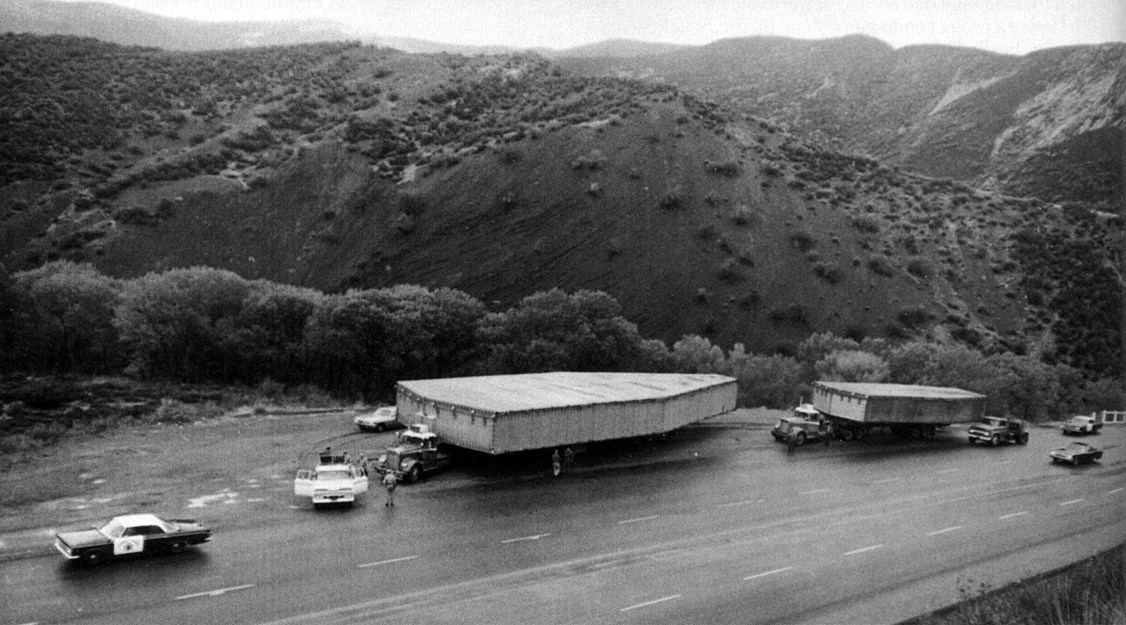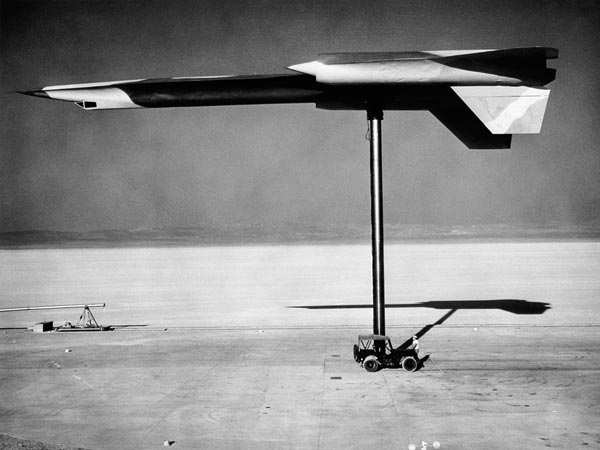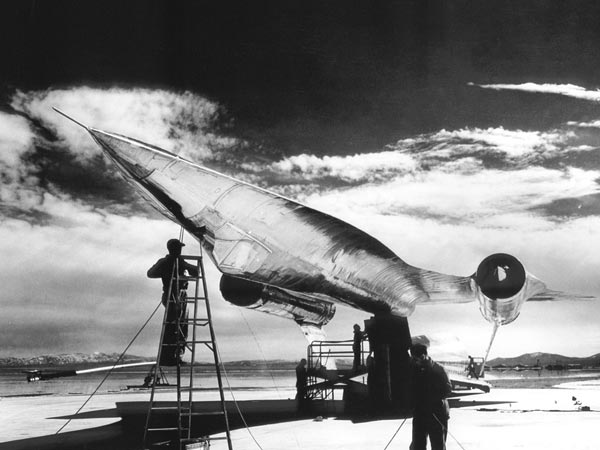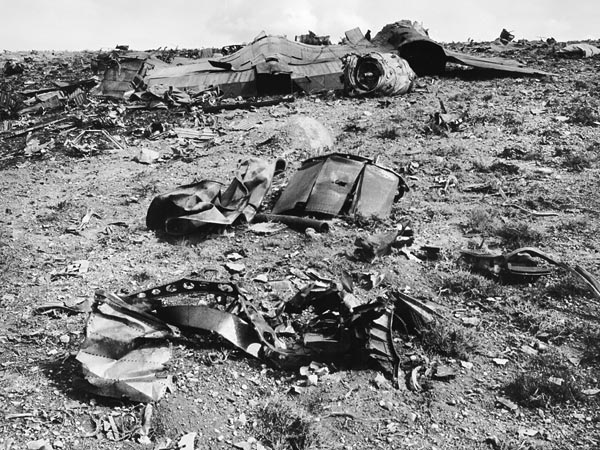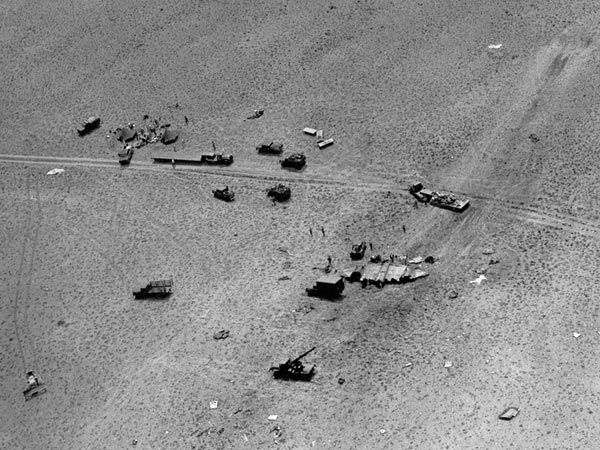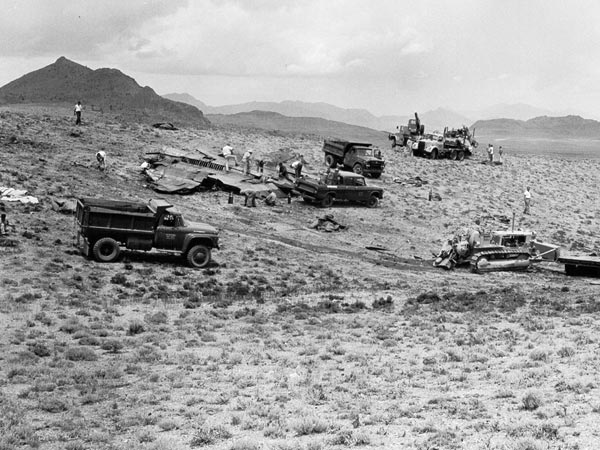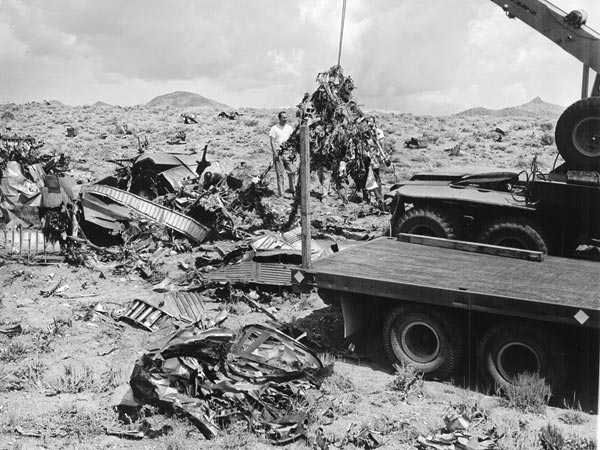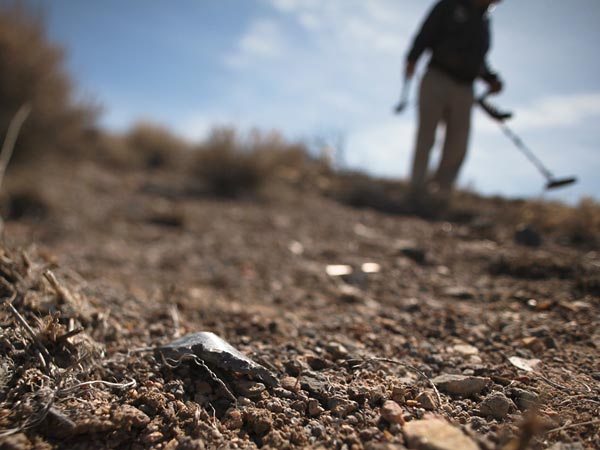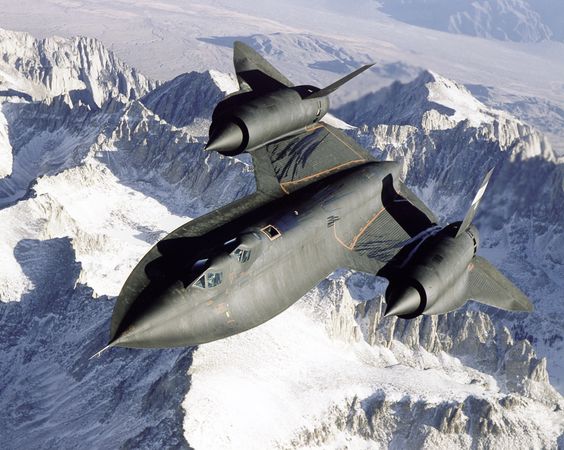|
Nevada Area 51 |
||
|
..
After decades of denying the
facility's existance, five former insiders speak out
Area 51. It's the most famous military institution in the world that doesn't officially exist. If it did, it would be found about 100 miles outside Las Vegas in Nevada's high desert, tucked between an Air Force base and an abandoned nuclear testing ground. Then again, maybe not-- the U.S. government refuses to say. You can't drive anywhere close to it, and until recently, the airspace overhead was restricted--all the way to outer space. Any mention of Area 51 gets redacted from official documents, even those that have been declassified for decades. It has become the holy grail for conspiracy theorists, with UFOlogists positing that the Pentagon reverse engineers flying saucers and keeps extraterrestrial beings stored in freezers. Urban legend has it that Area 51 is connected by underground tunnels and trains to other secret facilities around the country. In 2001, Katie Couric told Today Show audiences that 7 percent of Americans doubt the moon landing happened--that it was staged in the Nevada desert. Millions of X-Files fans believe the truth may be "out there," but more likely it's concealed inside Area 51's Strangelove-esque hangars--buildings that, though confirmed by Google Earth, the government refuses to acknowledge. The problem is the myths of Area 51 are hard to dispute if no one can speak on the record about what actually happened there. Well, now, for the first time, someone is ready to talk--in fact, five men are, and their stories rival the most outrageous of rumors. Colonel Hugh "Slip" Slater, 87, was commander of the Area 51 base in the 1960s. Edward Lovick, 90, featured in "What Plane?" in LA's March issue, spent three decades radar testing some of the world's most famous aircraft (including the U-2, the A-12 OXCART and the F-117). Kenneth Collins, 80, a CIA experimental test pilot, was given the silver star. Thornton "T.D." Barnes, 72, was an Area 51 special-projects engineer. And Harry Martin, 77, was one of the men in charge of the base's half-million-gallon monthly supply of spy-plane fuels. Here are a few of their best stories--for the record: On May 24, 1963, Collins flew out of Area 51's restricted airspace in a top-secret spy plane code-named OXCART, built by Lockheed Aircraft Corporation. He was flying over Utah when the aircraft pitched, flipped and headed toward a crash. He ejected into a field of weeds. Almost 46 years later, in late fall of 2008, sitting in a coffee shop in the San Fernando Valley, Collins remembers that day with the kind of clarity the threat of a national security breach evokes: "Three guys came driving toward me in a pickup. I saw they had the aircraft canopy in the back. They offered to take me to my plane." Until that moment, no civilian without a top-secret security clearance had ever laid eyes on the airplane Collins was flying. "I told them not to go near the aircraft. I said it had a nuclear weapon on-board." The story fit right into the Cold War backdrop of the day, as many atomic tests took place in Nevada. Spooked, the men drove Collins to the local highway patrol. The CIA disguised the accident as involving a generic Air Force plane, the F-105, which is how the event is still listed in official records. As for the guys who picked him up, they were tracked down and told to sign national security nondisclosures. As part of Collins' own debriefing, the CIA asked the decorated pilot to take truth serum. "They wanted to see if there was anything I'd for-gotten about the events leading up to the crash." The Sodium Pento-thal experience went without a hitch--except for the reaction of his wife, Jane. "Late Sunday, three CIA agents brought me home. One drove my car; the other two carried me inside and laid me down on the couch. I was loopy from the drugs. They handed Jane the car keys and left without saying a word." The only conclusion she could draw was that her husband had gone out and gotten drunk. "Boy, was she mad," says Collins with a chuckle. "We couldn't have told you any of this a year ago," Slater says. "Now we can't tell it to you fast enough." At the time of Collins' accident, CIA pilots had been flying spy planes in and out of Area 51 for eight years, with the express mission of providing the intelligence to prevent nuclear war. Aerial reconnaissance was a major part of the CIA's preemptive efforts, while the rest of America built bomb shelters and hoped for the best. "It wasn't always called Area 51," says Lovick, the physicist who developed stealth technology. His boss, legendary aircraft designer Clarence L. "Kelly" Johnson, called the place Paradise Ranch to entice men to leave their families and "rough it" out in the Nevada desert in the name of science and the fight against the evil empire. "Test pilot Tony LeVier found the place by flying over it," says Lovick. "It was a lake bed called Groom Lake, selected for testing because it was flat and far from anything. It was kept secret because the CIA tested U-2s there." When Frances Gary Powers was shot down over Sverdlovsk, Russia, in 1960, the U-2 program lost its cover. But the CIA already had Lovick and some 200 scientists, engineers and pilots working at Area 51 on the A-12 OXCART, which would outfox Soviet radar using height, stealth and speed. Col. Slater was in the outfit of six pilots who flew OXCART missions during the Vietnam War. Over a Cuban meat and cheese sandwich at the Bahama Breeze restaurant off the Las Vegas Strip, he says, "I was recruited for the Area after working with the CIA's classified Black Cat Squadron, which flew U-2 missions over denied territory in Mainland China. After that, I was told, 'You should come out to Nevada and work on something interesting we're doing out there.' " Even though Slater considers himself a fighter pilot at heart--he flew 84 missions in World War II--the opportunity to work at Area 51 was impossible to pass up. "When I learned about this Mach-3 aircraft called OXCART, it was completely intriguing to me--this idea of flying three times the speed of sound! No one knew a thing about the program. I asked my wife, Barbara, if she wanted to move to Las Vegas, and she said yes. And I said, 'You won't see me but on the weekends,' and she said, 'That's fine!' " At this recollection, Slater laughs heartily. Barbara, dining with us, laughs as well. The two, married for 63 years, are rarely apart today. "We couldn't have told you any of this a year ago," Slater says. "Now we can't tell it to you fast enough." That is because in 2007, the CIA began declassifying the 50-year-old OXCART program. Today, there's a scramble for eyewitnesses to fill in the information gaps. Only a few of the original players are left. Two more of them join me and the Slaters for lunch: Barnes, formerly an Area 51 special-projects engineer, with his wife, Doris; and Martin, one of those overseeing the OXCART's specially mixed jet fuel (regular fuel explodes at extreme height, temperature and speed), with his wife, Mary. Because the men were sworn to secrecy for so many decades, their wives still get a kick out of hearing the secret tales. Barnes was married at 17 (Doris was 16). To support his wife, he became an electronics wizard, buying broken television sets, fixing them up and reselling them for five times the original price. He went from living in bitter poverty on a Texas Panhandle ranch with no electricity to buying his new bride a dream home before he was old enough to vote. As a soldier in the Korean War, Barnes demonstrated an uncanny aptitude for radar and Nike missile systems, which made him a prime target for recruitment by the CIA--which indeed happened when he was 22. By 30, he was handling nuclear secrets. "The agency located each guy at the top of a certain field and put us together for the programs at Area 51," says Barnes. As a security precaution, he couldn't reveal his birth name--he went by the moniker Thunder. Coworkers traveled in separate cars, helicopters and airplanes. Barnes and his group kept to themselves, even in the mess hall. "Our special-projects group was the most classified team since the Manhattan Project," he says. Harry Martin's specialty was fuel. Handpicked by the CIA from the Air Force, he underwent rigorous psychological and physical tests to see if he was up for the job. When he passed, the CIA moved his family to Nevada. Because OXCART had to refuel frequently, the CIA kept supplies at secret facilities around the globe. Martin often traveled to these bases for quality-control checks. He tells of preparing for a top-secret mission from Area 51 to Thule, Greenland. "My wife took one look at me in these arctic boots and this big hooded coat, and she knew not to ask where I was going." So, what of those urban legends--the UFOs studied in secret, the underground tunnels connecting clandestine facilities? For decades, the men at Area 51 thought they'd take their secrets to the grave. At the height of the Cold War, they cultivated anonymity while pursuing some of the country's most covert projects. Conspiracy theories were left to popular imagination. But in talking with Collins, Lovick, Slater, Barnes and Martin, it is clear that much of the folklore was spun from threads of fact.
As for the myths of reverse engineering of flying saucers, Barnes offers some insight: "We did reverse engineer a lot of foreign technology, including the Soviet MiG fighter jet out at the Area"--even though the MiG wasn't shaped like a flying saucer. As for the underground-tunnel talk, that, too, was born of truth. Barnes worked on a nuclear-rocket program called Project NERVA, inside underground chambers at Jackass Flats, in Area 51's backyard. "Three test-cell facilities were connected by railroad, but everything else was underground," he says. And the quintessential Area 51 conspiracy--that the Pentagon keeps captured alien spacecraft there, which they fly around in restricted airspace? Turns out that one's pretty easy to debunk. The shape of OXCART was unprece-dented, with its wide, disk-like fuselage designed to carry vast quantities of fuel. Commercial pilots cruising over Nevada at dusk would look up and see the bottom of OXCART whiz by at 2,000-plus mph. The aircraft's tita-nium body, moving as fast as a bullet, would reflect the sun's rays in a way that could make anyone think, UFO. In all, 2,850 OXCART test flights were flown out of Area 51 while Slater was in charge. "That's a lot of UFO sightings!" Slater adds. Commercial pilots would report them to the FAA, and "when they'd land in California, they'd be met by FBI agents who'd make them sign nondisclosure forms." But not everyone kept quiet, hence the birth of Area 51's UFO lore. The sightings incited uproar in Nevada and the surrounding areas and forced the Air Force to open Project BLUE BOOK to log each claim. Since only a few Air Force officials were cleared for OXCART (even though it was a joint CIA/USAF project), many UFO sightings raised internal military alarms. Some generals believed the Russians might be sending stealth craft over American skies to incite paranoia and create widespread panic of alien invasion. Today, BLUE BOOK findings are housed in 37 cubic feet of case files at the National Archives--74,000 pages of reports. A keyword search brings up no mention of the top-secret OXCART or Area 51. Project BLUE BOOK was shut down in 1969--more than a year after OXCART was retired. But what continues at America's most clandestine military facility could take another 40 years to disclose. ANNIE JACOBSEN is an investigative reporter who sat for more than 500 interviews after she broke the story on terrorists probing commercial airliners. When she isn't digging into intelligence issues for the likes of the National Review, she's snapping together Legos with her two boys. SOURCE: Annie Jacobson for the LA Times |
||
|
..
Photograph from Roadrunners Internationale via Pangloss Films Credit: National Geographic "Hoot and scoot" sheds and cardboard decoys hid high-tech prototypes. Brian Handwerk
ON TV: Area 51 Declassified premieres on the National Geographic Channel on Saturday, May 28, at 10:00 p.m. ET/PT. No word yet on alien starships, but now that many Cold War-era Area 51 documents have been declassified, veterans of the secret U.S. base are revealing some of the clever—and surprisingly low-tech—ways they hid futuristic prototypes from prying eyes. (Also see "Exclusive Area 51 Pictures: Secret Plane Crash Revealed.") The CIA created Area 51 in 1955 to test and develop top secret U.S. military projects in the remote Nevada desert. More than 50 years later, the base still doesn't officially exist and appears on no public U.S. government maps. In the 1950s and '60s, Area 51 was the epicenter of the OXCART project, intended to create the successor for the U-2 spy plane. The OXCART plane was expected to be undetectable in the air as it flew surveillance and information-gathering missions over the Soviet Union. But Area 51 personnel soon found it necessary to conceal the craft from the Soviets eyes even when it was still being tested on the ground. Cat and Mouse at Area 51 It was discovered that Soviet spy satellites, dubbed ash cans by Area 51 staff, were making regular rounds over Nevada. U.S. intelligence agencies, though, provided Area 51 workers with a decisive advantage in this international "game of cat and mouse," according to T.D. Barnes, a former hypersonic flight specialist at Area 51 whose expertise was in electronic counter measures. No longer sworn to secrecy by the CIA, Barnes said, "In our morning security meetings, they'd give us a roster of the satellites that the Soviets had in the air, and we'd know the exact schedule of when they were coming over. "It was like a bus schedule, and it even told us whether it was an infrared satellite or what type it was," Barnes told National Geographic news. The Area 51 Hoot and Scoot Often hoisted atop tall poles for radar tests of the planes' stealthiness, OXCART prototypes were tested outside—making the Soviet spy satellites especially aggravating. "We had hoot-and-scoot sheds, we called them," Barnes says in the new National Geographic Channel documentary Area 51 Declassified. (The Channel is part-owned by the National Geographic Society, which owns National Geographic News.) "If a plane happened to be out in the open while a satellite was coming over the horizon, they would scoot it into that building." Former Area 51 procurement manager Jim Freedman adds, "That made the job very difficult, very difficult. "To start working on the aircraft and then have to run it back into the hangar and then pull it out and then put it in and then pull it out—it gets to be quite a hassle," Freedman says in the film. (Also see "Cold War Spy Plane Found in Baltic Sea.") Shadows of Area 51 It turned out that even laborious hooting and scooting weren't enough. Spies had learned that the Soviets had a drawing of an OXCART plane—obtained, it was assumed, via an infrared satellite. As a plane sat in the hot desert, its shadow would create a relatively cool silhouette, visible in infrared even after the plane had been moved inside. "It's like a parking lot," Barnes told National Geographic News. "After all the cars have left you can still see how many were parked there [in infrared] because of the difference in ground temperatures." To thwart the infrared satellites, Area 51 crews began constructing fanciful fake planes out of cardboard and other mundane materials, to cast misleading shadows for the Soviets to ponder. (Not intended to be seen, the decoys themselves were scooted out of sight before satellite flyovers.) Sometimes staff even fired up heaters near imaginary engine locations to make it look as if planes had just landed. "We really played with the infrared satellites," Barnes recalled. Ahead of Its Time—And Gone Before Its Time? As for the real U-2 successor, the Soviets never solved the secrets of OXCART before the program was made public in the mid-1960s. But during the course of some 2,850 top-secret test flights numerous people did see an oddly shaped (for the time), Mach-3 aircraft. Unidentifiable even to air controllers or commercial pilots, the gleaming titanium craft no doubt helped fuel the persistent rumors connecting UFOs with Area 51. In the end, the result of all the subterfuge was the Archangel-12, or A-12, considered by some to be the first true stealth plane. (Related: "'Hitler's Stealth Fighter' Re-created.") The A-12 could travel over 2,000 miles an hour (3,220 kilometers an hour) and cross the continental U.S. in 70 minutes—all while taking pictures that could resolve foot-long objects on the ground from an altitude of 90,000 feet (27,430 meters). But despite being "the most advanced aircraft ever built," as CIA historian David Robarge writes, the A-12 never saw spy service over the Soviet Union. And just as the Archangel was to be deemed ready for operation, its successor, the U.S. Air Force's famed SR-71 Blackbird, was already in the works. Due to fiscal pressures and Air Force/CIA competition, Robarge writes, the A-12, one of Area 51's greatest creations—at least that we know about—was decommissioned in 1968 after only a year in active service. |
||
|
..
Photograph from Roadrunners Internationale via Pangloss Films Credit: National Geographic Area 51 Spy Plane, Intact Brian Handwerk
Suspended upside down, a titanium A-12 spy-plane prototype is prepped for radar testing at Area 51 in the late 1950s. After a rash of declassifications, details of Cold War workings at the Nevada base, which to this day does not officially exist, are coming to light—including never before released images of an A-12 crash and its cover-up. (Also see "Revealed: How Area 51 Hid Secret Craft.") Area 51 was created so that U.S. Cold Warriors with the highest security clearances could pursue cutting-edge aeronautical projects away from prying eyes. During the 1950s and '60s Area 51’s top-secret OXCART program developed the A-12 as the successor to the U-2 spy plane. Nearly undetectable to radar, the A-12 could fly at 2,200 miles an hour (3,540 kilometers an hour)—fast enough to cross the continental U.S. in 70 minutes. From 90,000 feet (27,400 meters), the plane's cameras could capture foot-long (0.3-meter-long) objects on the ground below. But pushing the limits came with risks—and a catastrophic 1963 crash of an A-12 based out of Area 51. A rapid government cover-up removed nearly all public traces of the wrecked A-12—pictured publicly for the first time in this gallery, thanks to the CIA's recent declassification of the images. (Learn more about Area 51 from the National Geographic Channel.) —Brian Handwerk Published May 20, 2011 SOURCE: Exclusive Area 51 Pictures: Secret Plane Crash Revealed |
||
|
..
Photograph from CIA via Pangloss Films Credit: National Geographic Brian Handwerk
Stranded Far From Area 51 Remnants of a crashed A-12 spy plane—including two engines and the shattered rear fuselage—litter the ground near Wendover, Utah, in a 1963 picture recently declassified by the CIA and published here for the first time. Things went horribly wrong for test pilot Ken Collins (flying under his Area 51 code name Ken Colmar) when testing the plane's subsonic engines at low altitude. At 25,000 feet (7,620 meters), "the airplane pitched up and went up and got inverted and went into a flat incipient spin," Collins says in the new National Geographic Channel documentary Area 51 Declassified. (The Channel is part-owned by the National Geographic Society, which owns National Geographic News.) From such a position, "you just can't recover. So I thought I’d better eject, so I ejected down, because I was upside down." U.S. officials later asked Collins to undergo hypnosis and treatments of sodium pentothal (a "truth drug") to be sure he relayed every detail of the incident truthfully and correctly. (Also see "Cold War Spy Plane Found in Baltic Sea.") SOURCE: Stranded Far From Area 51 |
||
|
..
Photograph from CIA via Pangloss Films Credit: National Geographic Brian Handwerk
Cover-up Crew An aerial photo shows a massive rapid-response team at the site of the A-12 crash near Wendover, Utah, in 1963. After pilot Ken Collins had parachuted to the ground, he was stunned to be greeted by three civilians in a pickup, who offered to give him a ride to the wreckage of his plane. Instead, Collins got them to give him a ride in the opposite direction, by telling them the plane had a nuclear weapon on board—a prearranged cover story to keep the Area 51 craft a secret. Soon a team of government agents appeared to direct a complete cleanup—and cover-up—operation. By the next morning, recovery crews had begun loading the wreckage on trucks for the return trip to Area 51 in Nevada. No one else approached the wreck site or even learned of the crash during the next half century. SOURCE: Cover-up Crew |
||
|
..
Photograph from CIA via Pangloss Films Credit: National Geographic Brian Handwerk
Removing the Evidence A government "sanitation" team uses heavy equipment, including bulldozers and cranes, to remove all traces of the A-12 spy plane from a 1963 crash site in the Utah desert. "There was some debate over whether to dynamite the large sections of wreckage, to make identification by unauthorized personnel more difficult," said independent aerospace historian Peter Merlin. Today that secrecy has outlived its use, according to CIA historian David Robarge, explaining why the crash photos have been declassified. "CIA records managers review [information requests] case-by-case to determine whether the information sought is still sensitive on national-security grounds. In their judgment, the photos of the 1963 crash no longer are, and so they were declassified and released," Robarge told National Geographic News. "In 2007 the CIA declassified over a thousand documents related to the OXCART program and published an unclassified history of it in conjunction with the acquisition from the Air Force of one of the nine remaining A-12 airframes," now on display at CIA headquarters, Robarge added. SOURCE: Removing the Evidence |
||
|
..
Photograph from CIA via Pangloss Films Credit: National Geographic Brian Handwerk
Removing the EvidenceLoading Spy-Plane Debris A government "sanitation" team uses heavy equipment, including bulldozers and cranes, to remove all traces of the A-12 spy plane from a 1963 crash site in the Utah desert. "There was some debate over whether to dynamite the large sections of wreckage, to make identification by unauthorized personnel more difficult," said independent aerospace historian Peter Merlin. Today that secrecy has outlived its use, according to CIA historian David Robarge, explaining why the crash photos have been declassified. "CIA records managers review [information requests] case-by-case to determine whether the information sought is still sensitive on national-security grounds. In their judgment, the photos of the 1963 crash no longer are, and so they were declassified and released," Robarge told National Geographic News. "In 2007 the CIA declassified over a thousand documents related to the OXCART program and published an unclassified history of it in conjunction with the acquisition from the Air Force of one of the nine remaining A-12 airframes," now on display at CIA headquarters, Robarge added. SOURCE: Removing the Evidence |
||
|
..
Photograph from CIA via Pangloss Films Credit: National Geographic Brian Handwerk
Loading Spy-Plane Debris A government "sanitation" team uses heavy equipment, including bulldozers and cranes, to remove all traces of the A-12 spy plane from a 1963 crash site in the Utah desert. "There was some debate over whether to dynamite the large sections of wreckage, to make identification by unauthorized personnel more difficult," said independent aerospace historian Peter Merlin. Today that secrecy has outlived its use, according to CIA historian David Robarge, explaining why the crash photos have been declassified. "CIA records managers review [information requests] case-by-case to determine whether the information sought is still sensitive on national-security grounds. In their judgment, the photos of the 1963 crash no longer are, and so they were declassified and released," Robarge told National Geographic News. "In 2007 the CIA declassified over a thousand documents related to the OXCART program and published an unclassified history of it in conjunction with the acquisition from the Air Force of one of the nine remaining A-12 airframes," now on display at CIA headquarters, Robarge added. SOURCE: Loading Spy-Plane Debris |
||
|
..
Photograph from CIA via Pangloss Films Credit: National Geographic Brian Handwerk
Wreckage Under Wraps Before the cleanup, after pilots from Area 51 had reported that the wreck in Utah was still identifiable, crews quickly covered all large pieces with tarps. "At the time of the crash, the OXCART program was a very closely kept secret, and any exposure of it—such as through a crash that got publicized—could have jeopardized its existence," the CIA's Robarge said. "If U.S. adversaries used that disclosure to figure out what the program was about, they might have been able to develop countermeasures that would make the aircraft vulnerable. "The U.S. government had to make sure that no traces of the 1963 crash might be found and give hostile powers insights into the engineering and aeronautical advances the program was making." SOURCE: Wreckage Under Wraps |
||
|
..
Photograph from Pangloss Films/NGT Credit: National Geographic Brian Handwerk
Pieces Left Behind Shards of titanium from the wrecked A-12 scatter the crash site as aerospace historian Peter Merlin recently searches the debris field with a metal detector. Merlin's research into recently declassified documents on the OXCART project unearthed a memorandum that reported that all traces of the plane had been removed from the crash scene in 1963. "My experience with crash sites, however, is that there is always something left," Merlin says in the Area 51 documentary. And in fact recent investigations of the site have turned up parts of the plane's wing structure as well as cockpit remnants still bearing the stamp "skunk works"—the covert department of the defense contractor Lockheed, which worked on the plane. SOURCE: Pieces Left Behind |
||
|
..
Photograph courtesy NASA Credit: National Geographic Brian Handwerk
Next Generation Flying intelligence missions from 1966 to 1990, the U.S. Air Force's SR-71 Blackbird (pictured: dual-cockpit version, for training) was in many ways a product of Area 51 testing and an evolution of the A-12, which was decommissioned in 1968. Compared to the A-12, the SR-71 was larger, carried more fuel, and featured sharp sides to improve both stability and stealth. Such advances led to numerous world records for altitude and speed—including a 64-minute flight from Los Angeles to Washington, D.C., in 1990. (Related: "'Hitler's Stealth Fighter' Re-created.") Today experts at Area 51 are likely working on the next generation of aircraft. But don't expect any information to emerge for several decades—despite the recent declassifications, CIA's Robarge still won't confirm the base exists. "Sorry," he said, "I can’t say anything about it." See more pictures of Area 51 on the National Geographic Channel website SOURCE: Next Generation |
||
| FAIR USE NOTICE: This page contains copyrighted material the use of which has not been specifically authorized by the copyright owner. Pegasus Research Consortium distributes this material without profit to those who have expressed a prior interest in receiving the included information for research and educational purposes. We believe this constitutes a fair use of any such copyrighted material as provided for in 17 U.S.C § 107. If you wish to use copyrighted material from this site for purposes of your own that go beyond fair use, you must obtain permission from the copyright owner. | ||
|
|

